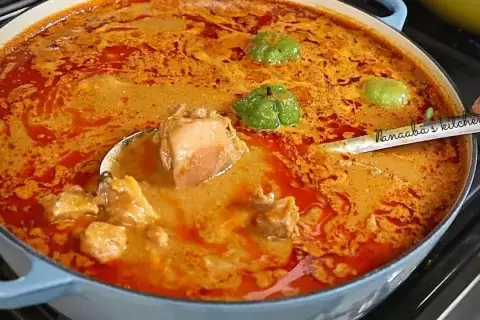Maafe, also known as groundnut stew, is a flavorful and hearty West African dish that has gained popularity around the world. Originating from countries such as Mali, Senegal, and Guinea, Maafe is traditionally prepared with a rich blend of peanuts, vegetables, meat (often chicken or beef), and an array of aromatic spices.
The dish is characterized by its thick and creamy texture, complemented by the natural sweetness of the peanuts and the savory notes from the spices. Maafe is typically served over rice or couscous, providing a satisfying and nourishing meal that delights the taste buds with its unique combination of flavors.
Whether enjoyed as a comfort food or as a cultural experience, Maafe offers a tantalizing journey into the vibrant culinary traditions of West Africa
Introduction
Welcome to our food blog, where we explore diverse culinary traditions from around the world.
Today, we are excited to present you with a recipe for Maafe, a flavorful and comforting West African dish that will transport your taste buds to the vibrant and rich cultural heritage of the region.
Also known as Groundnut Stew or Peanut stew, Maafe combines tender meat, vegetables, and a luscious peanut sauce to create a dish that is both satisfying and full of character.
Recipe
- Serves: 4-6
- Preparation Time: 20 minutes
- Cooking Time: 1 hour 30 minutes
Ingredients
- 2 pounds (900g) boneless beef or chicken, cut into bite-sized pieces
- 1 large onion, finely chopped
- 3 garlic cloves, minced
- 1 red bell pepper, diced
- 2 tablespoons vegetable oil
- 1 cup smooth peanut butter
- 4 cups beef or chicken stock
- 2 tomatoes, diced
- 2 carrots, peeled and sliced
- 2 sweet potatoes, peeled and cubed
- 1 cup okra, sliced (optional)
- 1 tablespoon tomato paste
- 1 teaspoon ground cumin
- 1 teaspoon ground coriander
- 1/2 teaspoon cayenne pepper (adjust to taste)
- Salt and pepper, to taste
- Fresh cilantro or parsley, for garnish
- Cooked rice, for serving
Preparation
- Heat the vegetable oil in a large pot or Dutch oven over medium heat. Add the onions and garlic, and sauté until translucent.
- Add the meat to the pot and brown it on all sides. This helps seal in the flavors and adds depth to the stew.
- Stir in the diced bell pepper, tomato paste, ground cumin, ground coriander, cayenne pepper, salt, and pepper. Cook for a few minutes until the spices release their aromas.
- Reduce the heat to medium-low and add the peanut butter, stirring well to combine with the meat and spices.
- Gradually pour in the stock while stirring to ensure a smooth sauce. Add the diced tomatoes, carrots, sweet potatoes, and okra (if using). Stir to incorporate all the ingredients.
- Cover the pot and simmer for about 1 hour, or until the meat is tender and the flavors have melded together. Stir occasionally to prevent sticking.
- Taste the Maafe and adjust the seasoning if needed. If the sauce is too thick, add a little more stock or water to achieve your desired consistency.
- Serve the Maafe hot over a bed of cooked rice. Garnish with fresh cilantro or parsley for added freshness.
Special Equipment
- Large pot or Dutch oven
- Cutting board and knife
- Wooden spoon or spatula
Serving Suggestions
Maafe is traditionally enjoyed as a main course, served over steamed white rice. The combination of the flavorful sauce and tender meat pairs wonderfully with the neutral taste of rice. You can also serve it with couscous, quinoa, or crusty bread to soak up the delicious sauce.
A side salad of fresh greens, sliced tomatoes, and cucumbers adds a refreshing touch to the meal.
Nutritional Value
Maafe is a nutrient-rich dish, providing a balance of proteins, healthy fats, and carbohydrates. The exact nutritional composition may vary based on the choice of meat and other ingredients used.
It offers a good amount of protein, vitamins, and minerals from the meat, vegetables, and peanut butter. Remember to adjust the nutritional information based on your specific recipe and serving size.
Cultural and Traditional Value
Maafe holds deep cultural and traditional significance in West Africa, particularly in countries like Senegal, Mali, and Guinea. It is often prepared during festive occasions, family gatherings, and religious ceremonies.
Maafe is a dish that brings people together, celebrating the warmth of community and the richness of African culinary heritage. The combination of local ingredients and cooking techniques creates a dish that is both delicious and a testament to the region's vibrant flavors.
Conclusion
Indulge in the flavors of West Africa with this comforting and hearty Maafe recipe. With its rich peanut sauce and tender meat, it's a dish that will transport you to the heart of West African cuisine.
Prepare it for your next family gathering or simply as a way to explore new flavors and traditions. Enjoy the cultural and culinary journey!














